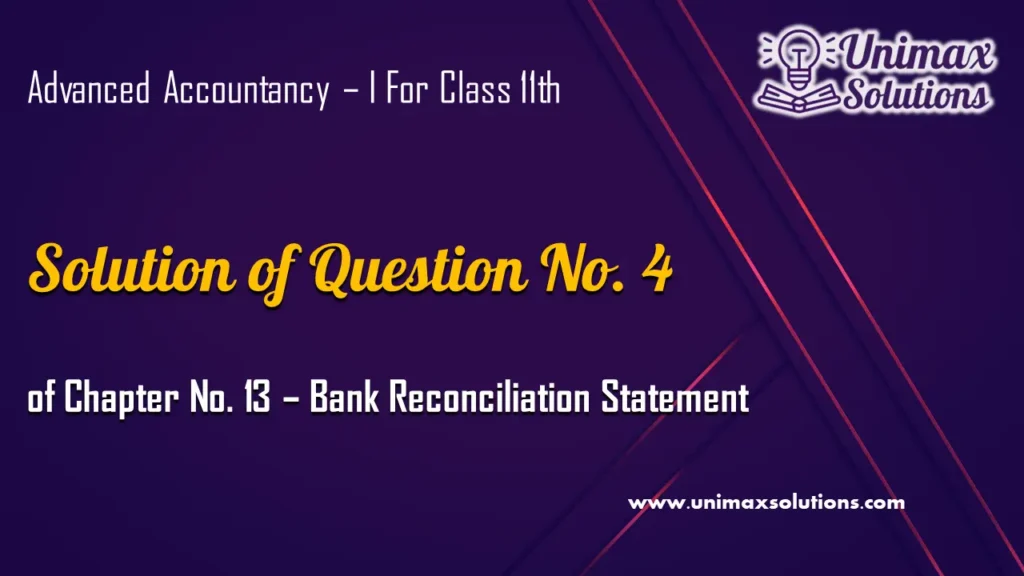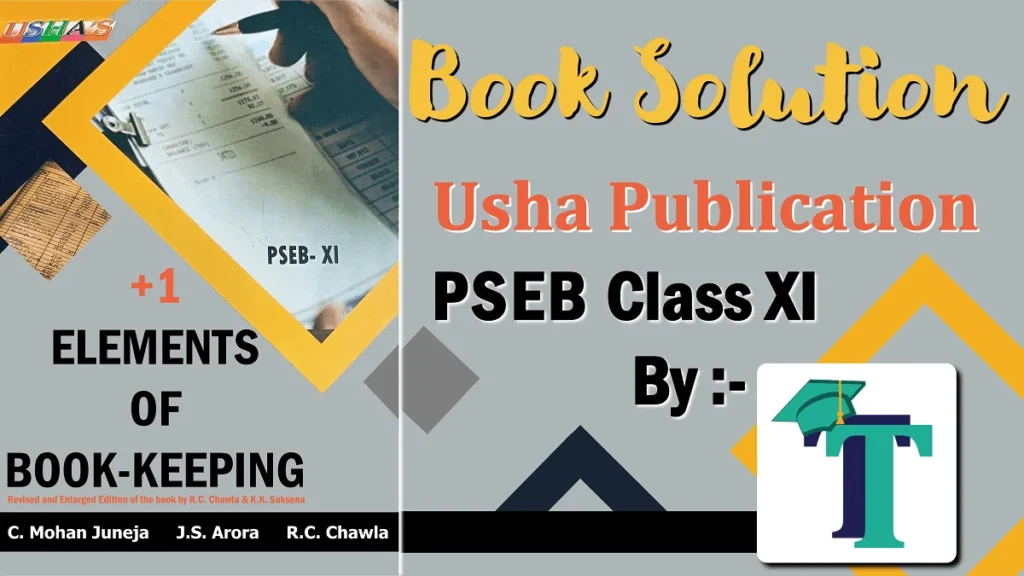
Advertisement
Question 4 Chapter 13 – Class 11 Unimax
A trader prepares at the end of each month a bank reconciliation statement for his business. Draft one such statement from the undermentioned items as on 31 December,2019.
(1) Cash and cheques totaling ₹ 36,950 were sent to bank in the month of December, but of these One cheque for ₹ 4,500 was credited in the pass book on 2nd January,2020.
(2) On 26th December cheque were drawn in favour of creditors for ₹ 9,500 but of these One cheque for ₹ 4,000 was in cashed on 2nd January,2020 and another for ₹ 3,000 has not yet been presented.
(3) One customer had deposited directly into bank ₹ 1,250 but there is no mention for the same in cash book.
(4) The trader had withdrawn from bank ₹ 3,500 but the same has not been entered in cash book.
(5) On 29th December a cheque for ₹ 3,000 was received and entered in the cash book but had been omitted to be sent to bank.
(6) On 27th December,2019 ₹ 175 were credited in pass book as six- monthly interest but the same had been recorded in the cash book on 31st December, 2019.
Advertisement
(7) Bank balance as per cash book ₹ 20,000.
The solution of Question 4 Chapter 13 – Class 11 Unimax:
| Particulars | Details | Amount |
| Balance as per cash book (Dr) | 20,000 | |
| Add: 1. Cheques issued but not presented | 7,000 | |
| 2. cheque directly paid by customer in bank | 1,250 | 8,250 |
| 28,250 | ||
| Less:1. Cheque paid but not cleared | 4,500 | |
| 2. withdrawn from bank by trader | 3,500 | |
| 3. cheque entered in cash book but not banked | 3,000 | 11,000 |
| Balance as per pass book | 17,250 | |
End of Solution
Check Out the Solution of all questions for this chapter:
The solutions to all questions of Chapter 13 – Bank Reconciliation Statement Unimax – Class 11 are shown as follows, click on the image of the question to get the solution.
Advertisement
Question 5 Chapter 13 – Class 11 Unimax
Advertisement
1. Comprehensive Solutions for All Chapters of Advanced Accountancy I Class 11 by Unimax
UnimaxSolutions.in offers a comprehensive solution for students studying Advanced Accountancy I Part 1 in Class 11. With their meticulously curated study material, students can access comprehensive solutions to all the questions included within each chapter. By selecting the chapter name from the study material, students can easily navigate through the topics and find detailed explanations and step-by-step solutions to the problems presented in that section. Whether it’s understanding complex accounting concepts, mastering calculation techniques, or analyzing financial statements, Unimax provides a valuable resource to aid students in their learning journey. With these comprehensive solutions at their disposal, students can enhance their understanding, clarify doubts, and improve their problem-solving skills in Advanced Accountancy, ensuring they are well-prepared for their Class 11 examinations.
- Chapter No. 1 – Introduction of Accounting
- Chapter No. 2 – Theory Base of Accounting
- Chapter No. 3 – Vouchers and Transactions
- Chapter No. 4 – Journal
- Chapter No. 5 – Goods and Services Tax (GST): An Introduction
- Chapter No. 6 – Ledger
- Chapter No. 7 – Special Purpose Book – Cash Book
- Chapter No. 8 – Other Subsidiary Books
- Chapter No. 9 – Trial Balance
- Chapter No. 10 – Rectification of Errors
- Chapter No. 11 – Depreciation
- Chapter No. 12 – Provision and Reserves
- Chapter No. 13 – Bank Reconciliation Statement
- Chapter No. 14 – Bills of Exchange
- Chapter No. 15 – Financial Statements (Without Adjustments)
- Chapter No. 16 – Financial Statements (With Adjustments)
- Chapter No. 17 – Accounts from Incomplete Records – Single Entry System
2. Punjab School Education Board (PSEB) Solutions of Usha Publication.
If you’re a student enrolled in the Punjab School Education Board Class 11, it’s essential to explore a wide range of books to cover the syllabus thoroughly. While the prescribed textbooks are undoubtedly valuable, supplementing your studies with additional resources can enhance your understanding and knowledge. Consider checking out other books that align with the curriculum, offering different perspectives and insights on the subjects you’re studying. These supplementary materials can provide you with alternative explanations, practice questions, and examples that may aid in clarifying complex concepts. Moreover, exploring diverse sources can expose you to a variety of writing styles and viewpoints, fostering a broader understanding of the subjects. So, seize the opportunity to expand your learning by delving into other books that can complement your studies and contribute to your academic growth.
Advertisement

